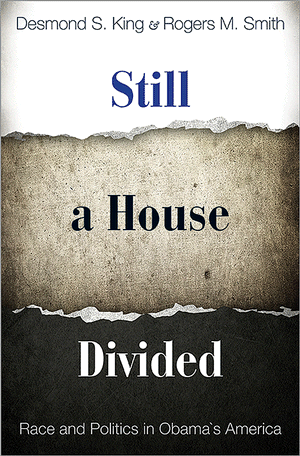Still a House Divided: Race and Politics in Obama’s AmericaPosted in Barack Obama, Books, Media Archive, Monographs, Politics/Public Policy, United States on 2012-09-27 03:44Z by Steven |
Still a House Divided: Race and Politics in Obama’s America
Princeton University Press
2011
320 pages
6 x 9; 5 halftones; 36 tables
Cloth ISBN: 9780691142630
eBook ISBN: 9781400839766
Desmond S. King, Andrew W. Mellon Professor of American Government
University of Oxford
Rogers M. Smith, Christopher H. Browne Distinguished Professor of Political Science
University of Pennsylvania
Why have American policies failed to reduce the racial inequalities still pervasive throughout the nation? Has President Barack Obama defined new political approaches to race that might spur unity and progress? Still a House Divided examines the enduring divisions of American racial politics and how these conflicts have been shaped by distinct political alliances and their competing race policies. Combining deep historical knowledge with a detailed exploration of such issues as housing, employment, criminal justice, multiracial census categories, immigration, voting in majority-minority districts, and school vouchers, Desmond King and Rogers Smith assess the significance of President Obama’s election to the White House and the prospects for achieving constructive racial policies for America’s future.
Offering a fresh perspective on the networks of governing institutions, political groups, and political actors that influence the structure of American racial politics, King and Smith identify three distinct periods of opposing racial policy coalitions in American history. The authors investigate how today’s alliances pit color-blind and race-conscious approaches against one another, contributing to political polarization and distorted policymaking. Contending that President Obama has so far inadequately confronted partisan divisions over race, the authors call for all sides to recognize the need for a balance of policy measures if America is to ever cease being a nation divided.
Presenting a powerful account of American political alliances and their contending racial agendas, Still a House Divided sheds light on a policy path vital to the country’s future.
TABLE OF CONTENTS
- List of Figures and Tables
- Acknowledgments
- PART ONE: Obama’s Inheritance
- PART TWO: The Making and Unmaking of Racial Hierarchies
- CHAPTER 2 “That is the last speech he will ever make”: The Antebellum Racial Alliances
- CHAPTER 3 “We of the North were thoroughly wrong”: How Racial Alliances Mobilized Ideas and Law
- PART THREE: The Trajectory of Racial Alliances
- CHAPTER 4 “This backdrop of entrenched inequality”: Affirmative Action in Work
- CHAPTER 5 To “affi rmatively further fair housing”: Enduring Racial Inequalities in American Homes and Mortgages
- CHAPTER 6 “To Elect One of Their Own”: Racial Alliances and Majority-Minority Districts
- CHAPTER 7 “Our goal is to have one classification-American” Vouchers for Schools and the Multiracial Census
- CHAPTER 8 “We can take the people out of the slums, but we cannot take the slums out of the people”: How Today’s Racial Alliances Shape Laws on Crime and Immigration
- PART FOUR: America’s Inheritance
- CHAPTER 9 Prospects of the House Divided
- Notes
- Index





